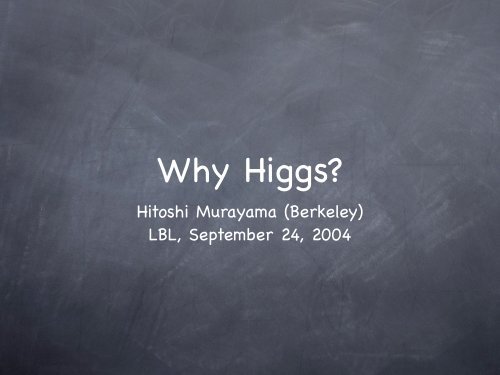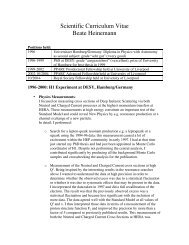Why Higgs - Www Atlas Lbl
Why Higgs - Www Atlas Lbl
Why Higgs - Www Atlas Lbl
You also want an ePaper? Increase the reach of your titles
YUMPU automatically turns print PDFs into web optimized ePapers that Google loves.
<strong>Why</strong> <strong>Higgs</strong>?<br />
Hitoshi Murayama (Berkeley)<br />
LBL, September 24, 2004
Outline<br />
<strong>Why</strong> We Need <strong>Higgs</strong><br />
Any Way Out?<br />
2
<strong>Why</strong> We Need <strong>Higgs</strong>
Mystery of<br />
the weak force<br />
Gravity pulls two<br />
massive bodies (longranged)<br />
Electric force repels<br />
two like charges<br />
(long-ranged)<br />
Weak force pulls<br />
protons and electrons<br />
(short-ranged) acts<br />
only over 10 –16 cm<br />
4
“Dark Field”<br />
gravity<br />
electric force<br />
weak force<br />
There is something filling our Universe<br />
It doesn’t disturb gravity or electric force<br />
It does disturb weak force and make it shortranged<br />
In fact, it is the “mother of mass” for all<br />
elementary particles<br />
What is it??<br />
5
Textbook<br />
W and Z are massive<br />
vector bosons<br />
Only known consistent<br />
(renormalizable)<br />
quantum field theory<br />
of massive vectors is<br />
gauge theory with<br />
<strong>Higgs</strong> mechanism<br />
Therefore, W and Z<br />
bosons must be gauge<br />
bosons, broken by a<br />
<strong>Higgs</strong><br />
S. Weinberg<br />
6<br />
! "<br />
# "<br />
0.2<br />
0.15<br />
0.1<br />
0.05<br />
0<br />
-0.05<br />
-0.1<br />
-0.15<br />
-0.2<br />
1.2<br />
1.15<br />
1.1<br />
1.05<br />
1<br />
0.95<br />
0.9<br />
0.85<br />
0.8<br />
0.9 1 1.1<br />
-0.1 0 0.1<br />
LEP charged TGC Combination 2002<br />
g 1<br />
Z<br />
! "<br />
# "<br />
1.25<br />
1.2<br />
1.15<br />
1.1<br />
1.05<br />
1<br />
0.95<br />
0.9<br />
0.85<br />
0.8<br />
0.75<br />
0.9 0.95 1 1.05 1.1<br />
DELPHI L3 OPAL Preliminary<br />
95% c.l.<br />
68% c.l.<br />
2d fit result<br />
Now added evidence of<br />
vector boson self-couplings<br />
g 1<br />
Z
Standard Model<br />
V=λ|H| 4 -μ 2 |H| 2<br />
The minimum of the<br />
potential has 2 =μ/2λ<br />
The scalar <strong>Higgs</strong> boson<br />
has two kinds of<br />
interactions with Z, W<br />
Once <strong>Higgs</strong> is replaced by<br />
the expectation value,<br />
there is mass for Z, W!<br />
Z<br />
Z<br />
! m Z<br />
2<br />
Z<br />
7
Mother of Masses<br />
It is not only W and Z bosons<br />
All elementary matter particles we know<br />
(quarks, leptons) get masses from the “Dark<br />
Field” from the Yukawa coupling<br />
y ¯f L f R H + c.c.<br />
How exactly neutrinos do that is still a big<br />
question!<br />
8
Like a superconductor<br />
In a superconductor, magnetic field gets repelled<br />
(Meißner effect), and penetrates only over the<br />
“penetration length”<br />
Magnetic field is short-ranged!<br />
Imagine a physicist living in a superconductor<br />
She finally figured:<br />
magnetic field must be long-ranged<br />
there must be a mysterious charge-two condensate in<br />
her “Universe”<br />
But doesn’t know what the condensate is, nor why it<br />
condenses<br />
Doesn’t have enough energy (gap) to break up Cooper<br />
pairs<br />
That’s the stage where we are!<br />
9
<strong>Higgs</strong> Boson is Most Likely<br />
“Just Around the Corner”<br />
<strong>Higgs</strong> boson<br />
= gap excitation<br />
Current data combined<br />
with the Standard<br />
Model theory predict<br />
m H<br />
unitarity<br />
W-boson scattering grows<br />
with energy AG F<br />
E 2 and<br />
violates unitarity at<br />
1.8TeV<br />
If you allow only one<br />
extra particle beyond<br />
what we know to restore<br />
unitarity, the only<br />
possibility is to add a spin<br />
zero particle whose<br />
couplings are precisely<br />
those of the SM <strong>Higgs</strong><br />
W +<br />
W +<br />
W ! W !<br />
W +<br />
W +<br />
W ! W ! W ! W !<br />
W +<br />
W +<br />
", Z<br />
", Z<br />
W + W +<br />
W +<br />
W +<br />
W ! W ! W ! W !<br />
H<br />
H<br />
C. H. Llewellyn Smith; D. A. Dicus and V. S. Mathur;<br />
J. M. Cornwall, D. N. Levin and G. Tiktopoulos<br />
11
ugly<br />
V=λ|H| 4 -μ 2 |H| 2<br />
<strong>Why</strong> negative masssqured?<br />
<strong>Why</strong> only one scalar in<br />
the SM?<br />
Hierarchy problem<br />
because of its quadratic<br />
divergence<br />
does not appear<br />
fundamental, i.e.<br />
Ginzburg-Landau vs BCS<br />
12
Once upon a time,<br />
there was a hierarchy problem...<br />
At the end of 19th century: a “crisis” about<br />
electron<br />
Like charges repel: hard to keep electric<br />
charge in a small pack<br />
Electron is point-like<br />
At least smaller than 10 –17 cm<br />
Need a lot of energy to keep it small!<br />
Δm e c 2 ~ α r e<br />
~ GeV 10 −17 cm<br />
r e<br />
Correction Δm e<br />
c 2 > m e<br />
c 2 for r e<br />
< 10 –13 cm<br />
Breakdown of theory of electromagnetism<br />
Can’t discuss physics below 10 –13 cm<br />
13
Anti-Matter Comes to Rescue<br />
by Doubling of #Particles<br />
Electron creates a<br />
force to repel itself<br />
Vacuum bubble of<br />
matter anti-matter<br />
creation/annihilation<br />
Electron annihilates<br />
the positron in the<br />
bubble<br />
only 10% of mass<br />
even for Planck-size<br />
14<br />
e – !<br />
e –<br />
!<br />
e +<br />
e – e + !<br />
∆m e<br />
m e<br />
∼ α 4π log(m er e )<br />
e –<br />
e –
History repeats itself?<br />
<strong>Higgs</strong> boson also<br />
repels itself<br />
Requires a lot of<br />
energy to contain<br />
itself in its point-like<br />
size!<br />
Breakdown of theory<br />
of weak force<br />
double #particles again<br />
superpartners<br />
“Vacuum bubbles” of<br />
superpartners cancel<br />
the energy required to<br />
contain <strong>Higgs</strong> boson in<br />
itself<br />
Δm 2 H ~ α 4π m 2<br />
SUSY<br />
log(m H r H )<br />
H<br />
H<br />
H<br />
Δm 2 H c 4 ⎛<br />
~ hc ⎞<br />
⎜ ⎟<br />
€ ⎝ ⎠<br />
r H<br />
2<br />
15<br />
H<br />
H ~ W<br />
~<br />
H
Good<br />
Even with Planck-scale cutoff, supersymmetry protects<br />
the hierarchy<br />
SUSY<br />
<strong>Higgs</strong> only one of many scalars that happen to<br />
acquire negative mass-squared<br />
SUSY stabilizes the hierarchy<br />
Dark Matter is quite natural in supersymmetry, once<br />
“R-parity” is imposed to avoid too rapid proton decay<br />
Typically neutralino=photino+zino+higgsino<br />
but could be gravitino etc<br />
makes gauge coupling constants unify GUT<br />
string theorists like it
Bad<br />
Tends to give excessive<br />
flavor-changing and/or<br />
CP-violating effects<br />
gravitino decays late and<br />
screw up Big-Bang<br />
Nucleosynthesis<br />
σ1/M Pl 2 ,<br />
~ ~<br />
d R<br />
s R<br />
d R d<br />
(! 12<br />
) RR<br />
g<br />
~<br />
g ~<br />
_<br />
K 0 K 0<br />
s R<br />
g<br />
~<br />
s R<br />
g<br />
~<br />
~<br />
d R<br />
d<br />
(! 12<br />
) RR<br />
s R<br />
d R<br />
g<br />
~<br />
Y 3/2<br />
σT 3 /(T 2 /M Pl<br />
)T/M Pl<br />
G ~<br />
g<br />
1/M Pl
Any Way Out?<br />
C. Csáki, C. Grojean, HM, J. Terning, L. Pilo<br />
hep-ph/0305237
unitarity again<br />
The only way to restore<br />
unitarity in WW scattering<br />
is to add <strong>Higgs</strong> boson<br />
True, if only one (or finite)<br />
particle<br />
What about an infinite<br />
tower of particles?<br />
extra dimensions give an<br />
infinite tower of Kaluza-<br />
Klein states<br />
Maybe another way to<br />
restore unitarity?<br />
need cancellations both in<br />
E 4 and E 2 terms<br />
19<br />
g 2 nnnn = !<br />
k<br />
4g 2 nnnnM 2 n = 3!<br />
k<br />
g 2 nnk<br />
g 2 nnkM 2 k
oundary conditions<br />
put theory on an interval [0, πR]×R 3,1<br />
impose boundary conditions at each<br />
boundary, i.e., Dirichlet or Neumann<br />
only Neumann 2 leads to zero modes<br />
regard W and Z boson as the lightest KK<br />
state<br />
No <strong>Higgs</strong> mechanism, no physical scalar<br />
bosons “<strong>Higgs</strong>less model”<br />
(all non-zero mode A can be “gauged away”)<br />
5<br />
y=0 y=!R<br />
20
Toy model<br />
SU(2) in the bulk<br />
boundary conditions break SU(2)→U(1)<br />
A μ 1,2 (0)=0, ∂ 5<br />
A μ 1,2 (0)=0<br />
∂ 5<br />
A μ 1,2,3 (πR)=0<br />
m γ<br />
=0, 2/R, 4/R, ...<br />
m W<br />
=1/R, 3/R, 5/R, ...<br />
scattering of the lowest W unitarized by the<br />
exchange of KK photons<br />
g 2 nnnn = !<br />
k<br />
g 2 nnk 4g 2 nnnnM 2 n = 3!<br />
k<br />
21<br />
y=0 y=!R<br />
g 2 nnkM 2 k
Can it be made<br />
realistic?<br />
Toy model does not reduce the rank e.g.,<br />
SU(2)×U(1)→U(1)<br />
Unrealistic mass spectrum. How can we<br />
make m and m different? How do they<br />
W Z<br />
depend on gauge couplings?<br />
can one incorporate fermion masses?<br />
22
More complicated<br />
boundary conditions<br />
can reduce the rank by imposing, e.g.,<br />
W μ 3 (0)+B μ<br />
(0)=0<br />
y=0 y=!R<br />
with gauge kinetic terms g -2 , such boundary<br />
conditions actually depend on gauge couplings<br />
semi-realistic example SU(2) ×SU(2) ×U(1) L R X<br />
at y=0, break SU(2) ×U(1) →U(1) R X Y<br />
M W k = 2k − 1<br />
4R<br />
at y=πR, break SU(2) L<br />
×SU(2) R<br />
→SU(2) D<br />
M Z k = M 0 + k − 1<br />
R<br />
! =<br />
M Z′<br />
k<br />
= −M 0 + k R<br />
M 2 W<br />
M 2 Z cos2 " W<br />
∼ 1.10<br />
23<br />
√<br />
M 0 = 1<br />
!R arctan 1 + 2g′2<br />
g 2 ∼ 0.29<br />
R
Anti-deSitter<br />
Later, Csáki, Grojean, Pilo, and Terning, hepph/0308038,<br />
proposed to use AdS instead,<br />
akin to Randall-Sundrum I setup<br />
on Plank brane, break SU(2) ×U(1) →U(1) R X Y<br />
on TeV brane, break SU(2) ×SU(2) →SU(2) L R D<br />
Main advantages<br />
the lowest W, Z more or less flat except<br />
for the vicinity of the TeV brane<br />
higher KK states much heavier than W, Z<br />
rho parameter = 1 to 1% level<br />
24
Further improvements<br />
Y. Nomura, hep-ph/0309189<br />
C. Csáki, C. Grojean, J. Hubisz, Y. Shirman,<br />
and J. Terning, hep-ph/0310355<br />
1st, 2nd generations localized close to the<br />
Plank brane<br />
3rd generation, esp right-handed top close to<br />
the TeV brane<br />
FCNC looks OK<br />
precision EW marginal<br />
more studies needed<br />
25
<strong>Higgs</strong>less<br />
phenomenology<br />
Whole tower of KK vector bosons=technirho’s<br />
mass: 300-2100 GeV<br />
Can be produced at LHC, on-resonance<br />
e + e -<br />
If on high-end, WW scattering becomes<br />
quite strong before the first resonance<br />
comes in<br />
interesting FCNC effects in the third<br />
generation<br />
may or may not have SUSY<br />
26
Conclusions<br />
We need a Dark Field filling up our universe<br />
We are approaching the correct energy scale<br />
to probe it<br />
Alternatives marginal<br />
Yet they predict something within reach<br />
We will know the answer!<br />
27




